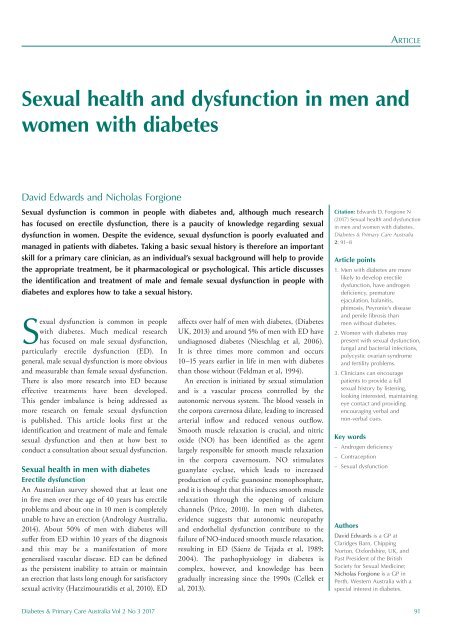DPCA 2-3_entire_v3
You also want an ePaper? Increase the reach of your titles
YUMPU automatically turns print PDFs into web optimized ePapers that Google loves.
Article<br />
Sexual health and dysfunction in men and<br />
women with diabetes<br />
David Edwards and Nicholas Forgione<br />
Sexual dysfunction is common in people with diabetes and, although much research<br />
has focused on erectile dysfunction, there is a paucity of knowledge regarding sexual<br />
dysfunction in women. Despite the evidence, sexual dysfunction is poorly evaluated and<br />
managed in patients with diabetes. Taking a basic sexual history is therefore an important<br />
skill for a primary care clinician, as an individual’s sexual background will help to provide<br />
the appropriate treatment, be it pharmacological or psychological. This article discusses<br />
the identification and treatment of male and female sexual dysfunction in people with<br />
diabetes and explores how to take a sexual history.<br />
Sexual dysfunction is common in people<br />
with diabetes. Much medical research<br />
has focused on male sexual dysfunction,<br />
particularly erectile dysfunction (ED). In<br />
general, male sexual dysfunction is more obvious<br />
and measurable than female sexual dysfunction.<br />
There is also more research into ED because<br />
effective treatments have been developed.<br />
This gender imbalance is being addressed as<br />
more research on female sexual dysfunction<br />
is published. This article looks first at the<br />
identification and treatment of male and female<br />
sexual dysfunction and then at how best to<br />
conduct a consultation about sexual dysfunction.<br />
Sexual health in men with diabetes<br />
Erectile dysfunction<br />
An Australian survey showed that at least one<br />
in five men over the age of 40 years has erectile<br />
problems and about one in 10 men is completely<br />
unable to have an erection (Andrology Australia,<br />
2014). About 50% of men with diabetes will<br />
suffer from ED within 10 years of the diagnosis<br />
and this may be a manifestation of more<br />
generalised vascular disease. ED can be defined<br />
as the persistent inability to attain or maintain<br />
an erection that lasts long enough for satisfactory<br />
sexual activity (Hatzimouratidis et al, 2010). ED<br />
affects over half of men with diabetes, (Diabetes<br />
UK, 2013) and around 5% of men with ED have<br />
undiagnosed diabetes (Nieschlag et al, 2006).<br />
It is three times more common and occurs<br />
10–15 years earlier in life in men with diabetes<br />
than those without (Feldman et al, 1994).<br />
An erection is initiated by sexual stimulation<br />
and is a vascular process controlled by the<br />
autonomic nervous system. The blood vessels in<br />
the corpora cavernosa dilate, leading to increased<br />
arterial inflow and reduced venous outflow.<br />
Smooth muscle relaxation is crucial, and nitric<br />
oxide (NO) has been identified as the agent<br />
largely responsible for smooth muscle relaxation<br />
in the corpora cavernosum. NO stimulates<br />
guanylate cyclase, which leads to increased<br />
production of cyclic guanosine monophosphate,<br />
and it is thought that this induces smooth muscle<br />
relaxation through the opening of calcium<br />
channels (Price, 2010). In men with diabetes,<br />
evidence suggests that autonomic neuropathy<br />
and endothelial dysfunction contribute to the<br />
failure of NO-induced smooth muscle relaxation,<br />
resulting in ED (Sáenz de Tejada et al, 1989;<br />
2004). The pathophysiology in diabetes is<br />
complex, however, and knowledge has been<br />
gradually increasing since the 1990s (Cellek et<br />
al, 2013).<br />
Citation: Edwards D, Forgione N<br />
(2017) Sexual health and dysfunction<br />
in men and women with diabetes.<br />
Diabetes & Primary Care Australia<br />
2: 91–8<br />
Article points<br />
1. Men with diabetes are more<br />
likely to develop erectile<br />
dysfunction, have androgen<br />
deficiency, premature<br />
ejaculation, balanitis,<br />
phimosis, Peyronie’s disease<br />
and penile fibrosis than<br />
men without diabetes.<br />
2. Women with diabetes may<br />
present with sexual dysfunction,<br />
fungal and bacterial infections,<br />
polycystic ovarian syndrome<br />
and fertility problems.<br />
3. Clinicians can encourage<br />
patients to provide a full<br />
sexual history by listening,<br />
looking interested, maintaining<br />
eye contact and providing<br />
encouraging verbal and<br />
non-verbal cues.<br />
Key words<br />
– Androgen deficiency<br />
– Contraception<br />
– Sexual dysfunction<br />
Authors<br />
David Edwards is a GP at<br />
Claridges Barn, Chipping<br />
Norton, Oxfordshire, UK, and<br />
Past President of the British<br />
Society for Sexual Medicine;<br />
Nicholas Forgione is a GP in<br />
Perth, Western Australia with a<br />
special interest in diabetes.<br />
Diabetes & Primary Care Australia Vol 2 No 3 2017 91
















